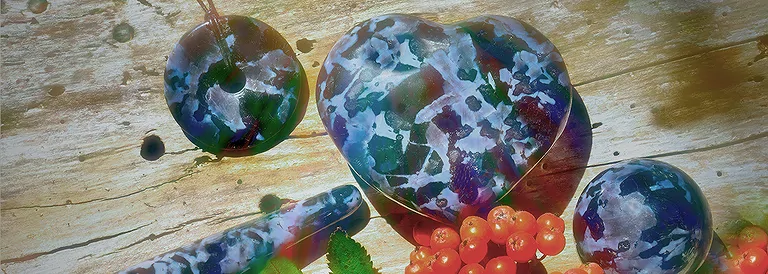
Gabbro (Mystic Merlinite) - bearing and meaning of a new gemstone
Gabbro accompanies to start with new things. Even if one has the feeling that everything runs in orderly courses, for sure a new project must be started. Let's listen to oneselves - what needs have been left unfulfilled, have remained unmet so far and what can be done to fulfill them? It is time for careful planning and Mystic Merlinte can help to tackle this task.
Mineralogical profile Gabbro (Mystic Merlinite)
Chemical Formula: diverse structures, coarse-grained igneous rock of plutonic origin; since Gabbro is a rock composed of many different minerals, there is no exact chemical formula.
Mineral Class: low-silica plutonite
Formation: primarily by crystallization deep in the earth's crust from magma
Color: gray to black, sometimes also purple, with greenish or bluish reflections on the surface
Crystal system: different, because rock and not a mineral
Mohs hardness: different, since rock and no mineral
Cleavability:various, since rock and no mineral
Localities, main supplier countries: Germany (Harz, Odenwald, Bavarian Forest), Madagascar, South Africa, India, Greenland
Appearance: Gabbro is a coarse-grained rock, which is composed of many different minerals. The light portion consists mainly of plagioclase Feldspar. Furthermore, quartz, Hornblende, biotite, Magnetite, Ilmenite and accompanying minerals like Pyrite, Magnetite and Apatite occur.
Availability: good
Massage stones, stringed beads, donuts and more gabbro items at reseller prices
Use: Gabbro has similar properties to Granite and is used as a building material in exterior and interior applications.
Gabbro as a massage stone is also part of the application developed by Monika Grundmann "Fire & Ice Gem Ritual" from the concept of gemstone balance. Here, different areas of the body are treated with the gabbro ball or the massage stylus made of Gabbro treated.
More information about Fire & Ice Gem Ritual

Origin of the name Gabbro and varieties
Gabbro was named by the German geologist Christian Leopold von Buch (1774 - 1853) after the locality of Gabbro near Florence. Gabbro is also sold in retail as well as wholesale under the name Mystic Merlinite.
The variety "Black Galaxy" (Bronzite Gabbro) is a dark, almost black rock and is mined since 1988 in Andhra Pradesh in India. In the trade it comes under the name "Black Galaxy", "Star Galaxy" and "Gold Galaxy". Under these names it is known among stonemasons as a decorative stone, which is good for making kitchen tiles and countertops. Mineralogically, it is Gabbro.
Meaning and use of Gabbro in gemstone healing
Gabbro shows good stability against weathering and is therefore popular for use as crushed stone and for cladding. However, gabbro also contains traces of Kcopper, platinum and silver, chromium, nickel and titanium and is a sought-after Raw material for the extraction of these metals.
It is only in the last few decades that Gabbro has been discovered as a gemstone by the stone healing community.
In gemstone healing, Gabbro stands for new beginnings. In times of tiring routine, the stone has a strengthening effect and encourages you to listen to yourself and perceive your own needs. It helps to carefully plan and prepare new things. With important changes, such as a move or a change of job, Gabbro provides the best possible support. The stone helps in situations where the change has already occurred due to external circumstances and one must now also mentally to the new circumstances. Gabbro promotes the necessary courage and optimism to be able to realize great plans.
The self-healing powers and the ability to regenerate are also supported by Gabbro; the stone gives a pleasant body feeling. Some users therefore put Gabbro in the sauna or in the bedroom. Like all stones of plutonic origin, Gabbro also strengthens the unity and firm connection of body and mind.
Gabbro and Basalt - gemstone "siblings"
Gabbro is a coarse-grained igneous rock of plutonic origin, meaning it crystallizes from a magma deep in the earth's crust. When the magma escapes to the earth's surface during a volcanic eruption, basalt is formed instead of gabbro. Gabbro is thus the plutonic counterpart of basalt, its chemical composition is exactly the same as that of basalt, the only difference between the two being their formation.
Externally, however, basalt and gabbro are quite distinct.
Gabbro has a crystalline structure, recognizable by the color variations visible to the naked eye, while basalt has a more homogeneous appearance.


